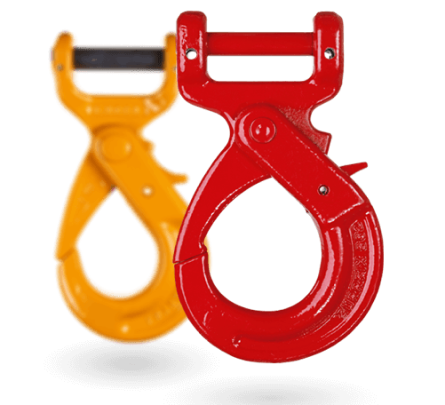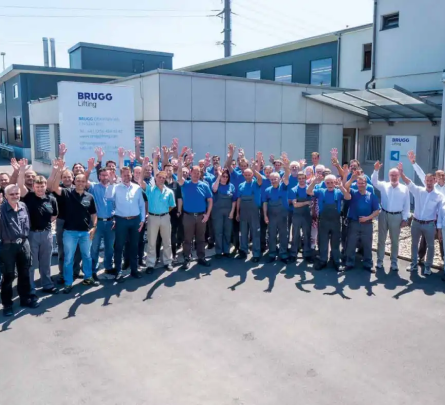DIFFERENT GRADES. EXTENSIVE ASSORTMENT
Slings and lifting straps
by BRUGG Lifting
Lifting points for use on construction sites, for logistics, in industrial or production halls – at BRUGG Lifting you can obtain high-strength eyebolts, weldable transport rings or rings suitable for bolting on, as well as lifting swivels for various payloads.
Matching our offered lifting points, you will also find a large selection of lifting equipment and slings as well as special lifting equipment according to customer specifications in our assortment.


The correct handling of slings and lifting straps
Slings and lifting straps from BRUGG Lifting enable you to lift practically any load on construction sites, in production halls and industrial plants. This gives you:
- Slings and lifting straps from 1-leg to 4-legs
- Chain slings of different grades from grade 8, grade 10 and grade 12 steel
- Round strand rope slings
- Lifting straps as a reverse suspension, construction suspension or lifting belt suspension
- Round slings and endless belts
- Accessories such as shackles, connecting links, various load hooks, etc.
In addition to common products from the areas of chain slings, rope slings, lifting straps and round slings, our wide range of slings and lifting gear offers suitable attachment points and special lifting equipment (including according to customer specifications).
Operating instructions for your slings
To help you being on the safe side when slinging loads, we have compiled some application instructions for slings and lifting gear.
Slinging of loads
- Does the safety catch of the load hook move properly?
- The safety catch of the hook must lock!
- Report any defect to the crane operator/supervisor
Can the material be transported in this state using the crane (intact packaging, stable wooden pallet, no loose parts)?
Sling chains, belts or ropes tightly around the material to be transported, so that the load will not be shifted when lifted.
- Signal to crane operator “slowly lift” by hand
- Supervise the lifting operation from short and safe distance
- If the load tilts over or if attachment points shift: signal “Stop” by hand
- Never correct floating load by hand!
- Is the sling gear undamaged (no cracks, cuts, crushes, noses)?
- Can the load be transported using the selected sling gear?
- Where to attach the sling gear at the material to be transported?
- The material to be transported must be transported in balanced position. Take the center of gravity of the load into account!
- Safe hold
- Alternative places, if the load tends to make uncontrolled movements
- Eye contact to the crane operator
- No danger of falling down and being trapped
- If the load floats narrowly above the floor, check whether: the load is suspended balanced and the attachment points remain stable?
- If yes: Signal “Lift” by hand
- Leave the swivel range of the crane
- Never stay below the floating load
Sling gear and lifting gear from our web shop
The sling gear and lifting gear from our web shop provides you with a large range of high-quality, secure and industrial safety (EKAS guidelines) tested rope slings, chain slings, lifting straps, attachment points and accessories. Our product range definitely offers the slings or lifting gear suitable for your specific purpose.
Advice on safe slinging with chain slings
The shortened load-bearing chain leg suspended in the shortening clutch must leave the shortening clutch downward in the alignment. If the load-bearing leg leaves the shortening clutch upward, the chain sling and the clutch will be overstressed, which will result in the lifting chain tearing or the clutch breaking off.
Chains should be only loaded in straight, untwisted and unknotted condition. Select the attachment points so that the end fittings, the chain links and the suspension links are not exposed to bending stresses.
Overly strong patting will once again reduce the natural stop angle of about 120°, which will lead to an unnecessary additional stress of the sling gear or lifting gear.
Stresses induced by sudden lifting or falling of loads will overload end fittings or single legs of the sling gear due to the strong forces of acceleration, which in extreme cases will result in deformations or tearing of the leg.
For lifting loads in narrow places, slingers should attach a fiber rope or a stable string functioning as a “drawstring” at one end or both ends of the load in order to control the lateral movement of the load.
Before lifting a load, slinger and crane operator should agree on a signal code for mutual understanding which also allows for quickly carrying out the proper maneuver in emergencies.
The load should always be put down on a place prepared with mats and never directly on the lifting device (damaging); this allows for the quick and easy removal of the sling gear.
To prevent unused chain legs from getting caught or jammed somewhere during the lifting operation, they should be hooked or tied back into the suspension link. Unused chain suspensions hanging in the crane hook should always be hooked back.
PRODUCT MANAGEMENT SYSTEM
The efficient product management system for any products, inspection dates and inspection logs
Did you know, that the free apps PVS and BRUGG.Lifting provide you with effective support for your use of slings and lifting gear?
Use PVS to manage your slings, lifting gear and many other products transparently including inspection cycles and corresponding inspection logs and to request new stock, repairs and inspections of your slings and lifting gear from within the app. More info on PVS.
Brugg.Lifting assists you with the calculation of maximum working load, length of the slings and stop angle. More about BRUGG.Lifting.

Download now:

Our range of lifting accessories at a glance
At BRUGG LIFTING, we offer a wide range of lifting accessories that meet the requirements in various industries. Our range includes round slings, endless webbing slings, lifting straps, reversing assemblies, construction assemblies, and much more. Each lifting accessory has been carefully developed and tested to ensure the highest level of safety and reliability.
Order lifting accessories securely online at BRUGG LIFTING
In our online shop, you can conveniently and securely order lifting accessories from BRUGG LIFTING. Our shop features a user-friendly interface that allows you to quickly find and order the desired lifting accessories. We place great importance on data privacy and security, so you can trust that your personal information is protected. In addition, our experienced staff is available to assist you with any questions or concerns.
When to use which lifting accessory? / Where are lifting accessories used?
Lifting accessories are used in a variety of applications. Depending on the load, environment, and specific requirements, different lifting accessories are used. For example, wire ropes and chains are commonly used in lifting technology, while round slings and lifting straps are used in logistics or cargo securing. It is important to choose the right lifting accessory for each application to ensure maximum safety and efficiency.
Safe use of lifting accessories
The safe use of lifting accessories is of utmost importance to prevent accidents or damages. It is important to properly inspect, maintain, and store lifting accessories. Proper application, correct load capacity calculations, and compliance with regulations are essential. At BRUGG LIFTING, we prioritize safety and offer training and consultation to ensure that users can safely use our lifting accessories.
What are lifting accessories?
Lifting accessories encompass a variety of products such as ropes, chains, lifting straps, webbing slings, round slings, and more. These lifting accessories are used to safely lift and transport loads. They are made from high-quality materials such as steel and meet high-quality standards to ensure reliability and safety. At BRUGG LIFTING, you will find a wide selection of lifting accessories that meet your requirements.
Lifting accessories regulations
The use of lifting accessories is subject to specific regulations and standards to ensure compliance with the required safety standards. These regulations establish requirements for load capacity, labeling, testing, and maintenance of lifting accessories. At BRUGG LIFTING, we strictly adhere to these regulations and ensure that our lifting accessories comply with applicable standards.
Inspection of lifting accessories
Regular inspections of lifting accessories are essential to ensure compliance with safety requirements and to identify any damages. At BRUGG LIFTING, we offer inspection services for lifting accessories to ensure that they meet the prescribed standards. Our trained inspection experts conduct thorough inspections and document the results to ensure that the lifting accessories meet the highest safety standards.
Material, construction, and load capacity of lifting accessories
Lifting accessories are made from various materials such as steel or textiles. The choice of material depends on the specific requirements of the application. For example, steel wire ropes and chains are suitable for heavy loads and rough environments, while textile lifting accessories such as round slings are lighter and more flexible. The construction of lifting accessories is designed to ensure high load capacity and reliability. They are carefully developed and manufactured to withstand the stresses of lifting and transporting.
Lifespan and special features of lifting accessories
The lifespan of lifting accessories can vary depending on usage, environment, and maintenance. It is important to conduct regular inspections and remove damaged or worn lifting accessories. Special attention should also be given to features such as edge protection, cargo securing, and proper application. At BRUGG LIFTING, we place great importance on the durability and reliability of our lifting accessories and offer high-quality products that meet the specific requirements of various industries.
Innovations and developments at BRUGG LIFTING
As a leading provider of lifting accessories and lifting technology, BRUGG LIFTING is constantly striving to develop innovative solutions. Our engineers and technicians continuously work on improving our products and developing new technologies. We rely on state-of-the-art manufacturing techniques and materials to produce lifting accessories that meet the highest requirements.
Why choose BRUGG LIFTING?
When selecting lifting accessories, it is important to rely on a trustworthy and reliable provider like BRUGG LIFTING. We offer high-quality lifting accessories that comply with applicable standards and regulations. Our extensive experience, expertise, and excellent customer service make us a reliable partner for your lifting technology requirements. We prioritize safety, quality, and customer satisfaction.